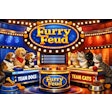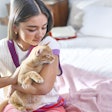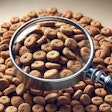.png?auto=format%2Ccompress&q=70&w=400)
The wet petfood market is increasingly oriented to consumer macro trends, such as product convenience and the humanization of pets. The increase of chunks in jelly launches, especially in single servings, echoes this orientation. In 2007, 15% of wet cat food launches were chunks in jelly vs. 11% in 2006 (Gnpd database, 2008).
Comprehensive approach
Nowadays not only pet tastes and nutritional requirements must be considered, but the consumer perception and enjoyment with pets are becoming more important in the petfood industry. So, research and development teams have to consider more sophisticated methods for designing products.
Various research fields can be integrated in the product development process, including physiochemical measurements, sensory analysis and consumer sciences. These data provide a multidimensional description of a product. In the petfood business, the palatability test classically used to evaluate product performance is based on consumption weighing that produces a one-dimensional response. Thus, innovative data treatment methods are needed to relate animals' preferences to product characteristics.
More sophisticated tools
Several statistical methods, such as preference mapping techniques, allow working out the correlation between consumers' ratings and product characteristics. In palatability assessment, the difficulty is posed by the imbalance between input data structure (product parameters) and output data (consumption amounts).
The PLS regression (partial least square) is a statistical method that produces a graphical display of the analyzed products, with their characteristics, and a mapping of the consumers' preferences. This method builds a causal scheme of relationships between sensory data, physicochemical bloc and hedonic judgments. These analytical scopes are centered on the assessed products and provide valuable descriptions of the consumers' preference profile. As opposed to linear regression analysis, PLS offers the possibility to model one variable (cat's food intake for instance) by a very high number of explanatory variables without risking an over adjustment.
This method was used in a comprehensive study carried out by SPF's Wet R&D team to investigate the interactions between texture of wet cat food and its palatability on chunks in jelly products.
Meat by-products are the main components of wet products, but the variability in raw materials leads to a high variability of texture. On the other hand, another material commonly used in wet products has a high textural regularity: the jelly. Rheological properties of gels after retorting can be predicted with relatively good precision, which makes them especially suitable models for research.
Experimental design
Four jellies were made using four different gelling agents with thermo-reversible properties to build an extended textural field (Figure 1). One jelly was representative of common jelly-based products found on the market. The same dose of palatability enhancer (SPF C'Sens) was added to each of the formulas.
Instrumental texture analysis was done using a penetrometry technique (measuring the penetrability of a material) for measurement of gel hardness, rigidity and springiness. The texture measurement showed highly significant divergences in texture amongst the four prototypes. The jellies were then assessed by a human sensory panel for texture and odor intensity characterization.
The jellies' characterization (texture, sensory description), and "cats first choices" were processed as input data. A full design and specific palatability testing in a cat expert panel (Panelis, France) provided cumulated individual consumption values as output data. The PLS permitted the comparison of individual preferences of the 40 cats with product characteristics to show the relationship between texture differences and palatability.
Texture and palatability correlated
Data obtained for the four jelly products (texture profiles, sensory evaluation and palatability preferences) are displayed in Figure 2. In this PLS plot, jellies A and D (harder gels) are divergent from jellies B and C (more elastic gels). The human sensory description of texture is correlated to the instrumentally measured texture according to the positioning of these variables. Cats' preferences are described by their relative proximity to product points.
The plot highlights a sensorial consensus centered on soft and elastic jellies that are characterized by higher odor intensity and first choices values. Hard and rigid jellies were clearly rejected by the majority of cats. This apparent negative correlation between palatability and gel strength lead to the hypothesis of a relationship with the flavor retention.
Matrix effect involved?
Renard (Renard et al ., 2006) explained that the more cohesive the structure (with a highly organized polysaccharide network), the more the volatile aromatic compounds are retained, and vice versa. His work indicates the matrix effect that can explain, in this study, how texture has a retention effect on flavor-release in the jellies and thus influence cats' preferences.
The sensory perception of gel texture can be divided into three main areas:
- The mechanical perception of food texture;
- The acoustic feeling during mastication; and
- The matrix effect.
Further experiments were conducted on gel texture modulation to produce controlled variations in jelly textures, and to assess cats' perceptions toward those differences. Odor induced consumption was shown in cats with another experimental device that showed the importance of flavor release in palatability. These observations corroborate the evidence of the matrix effect in cat preferences.
Complex and multi-variable
From the product design point of view, formulation and process parameters are known to impact directly on gel texture. Thus, through the matrix effect, they impact indirectly on palatability. For this reason, it is necessary to consider gel texture as a way to improve the performance of palatability enhancers.
The addition of chunks, the mineral content, pH properties, moisture transfers and thermal treatments affect gel texture. Based on these investigations, SPF's Wet Research team built a model of physicochemical interactions in chunks in jelly. The study of feline palatability remains a complex and multi-variable area. Improving knowledge requires developing innovative, sensitive data processing techniques.












